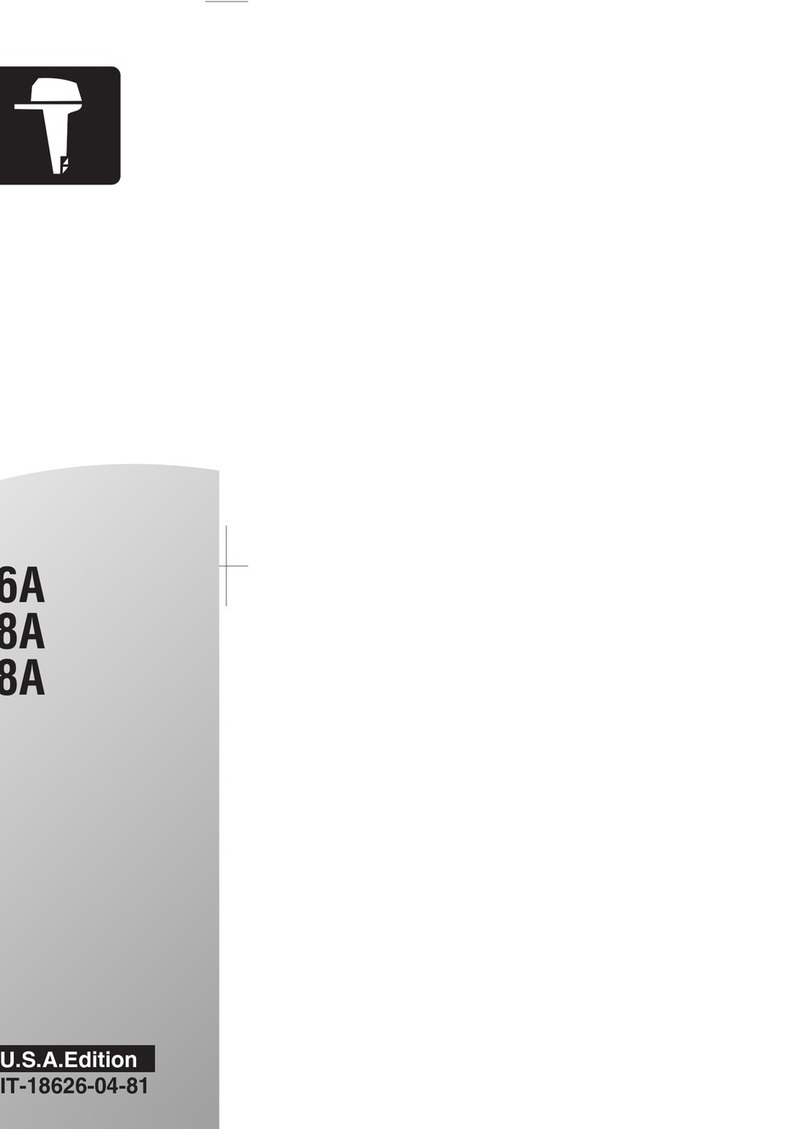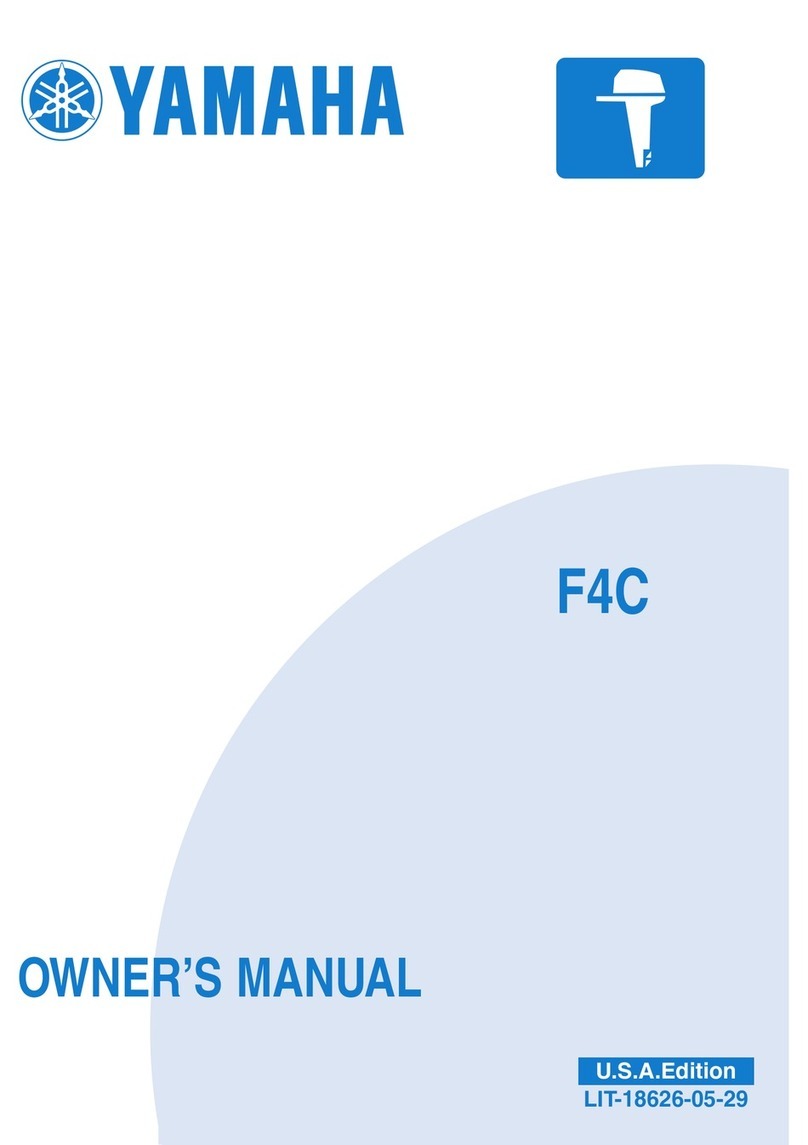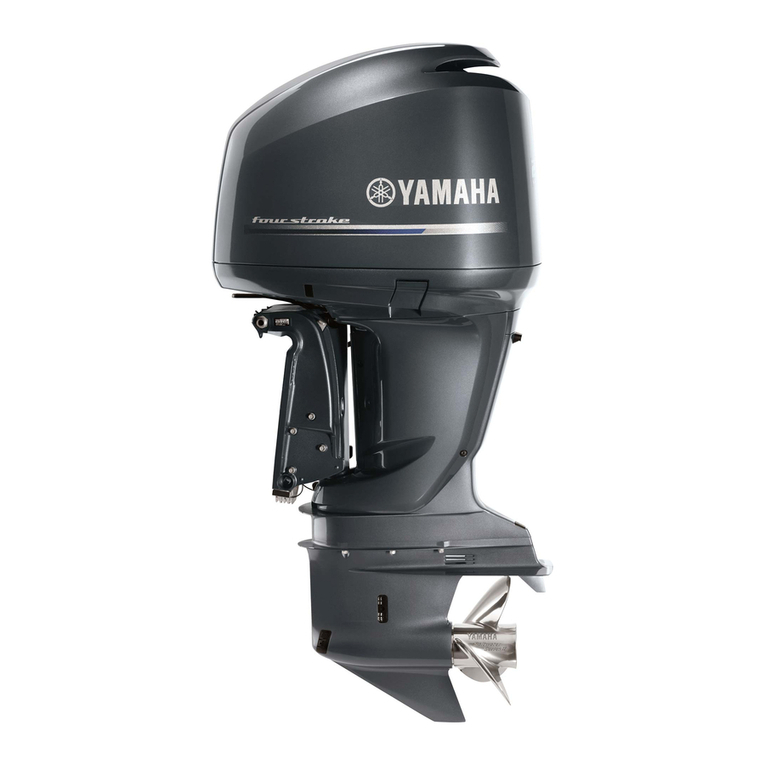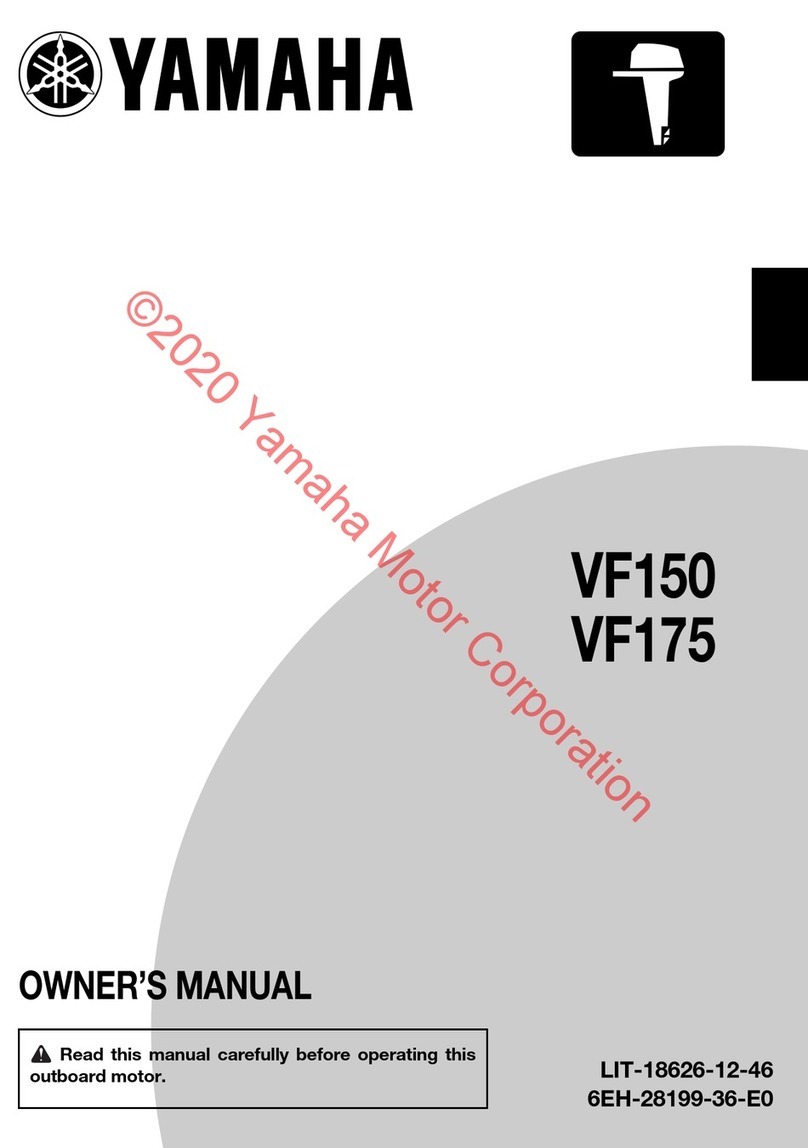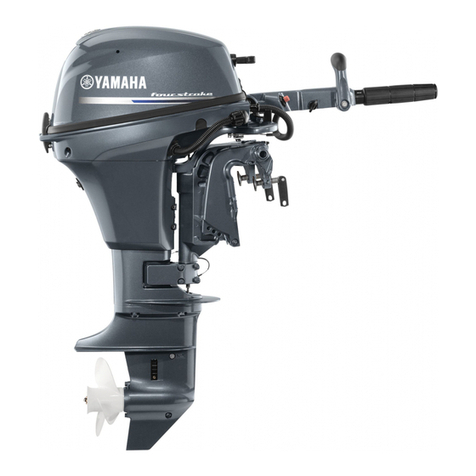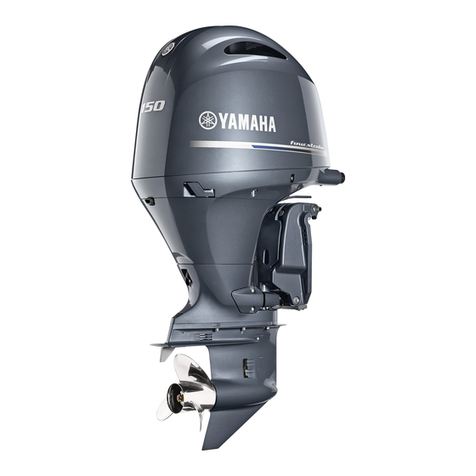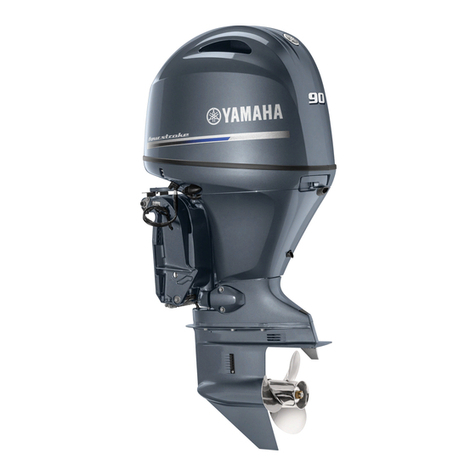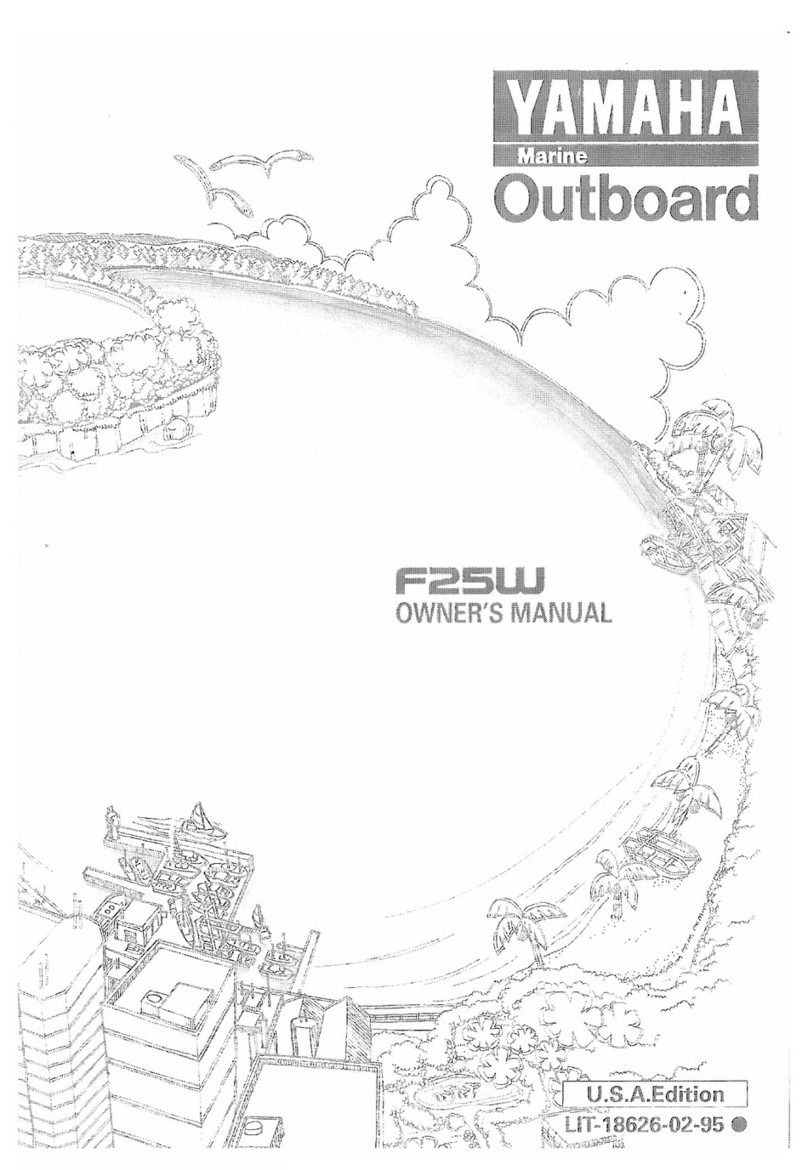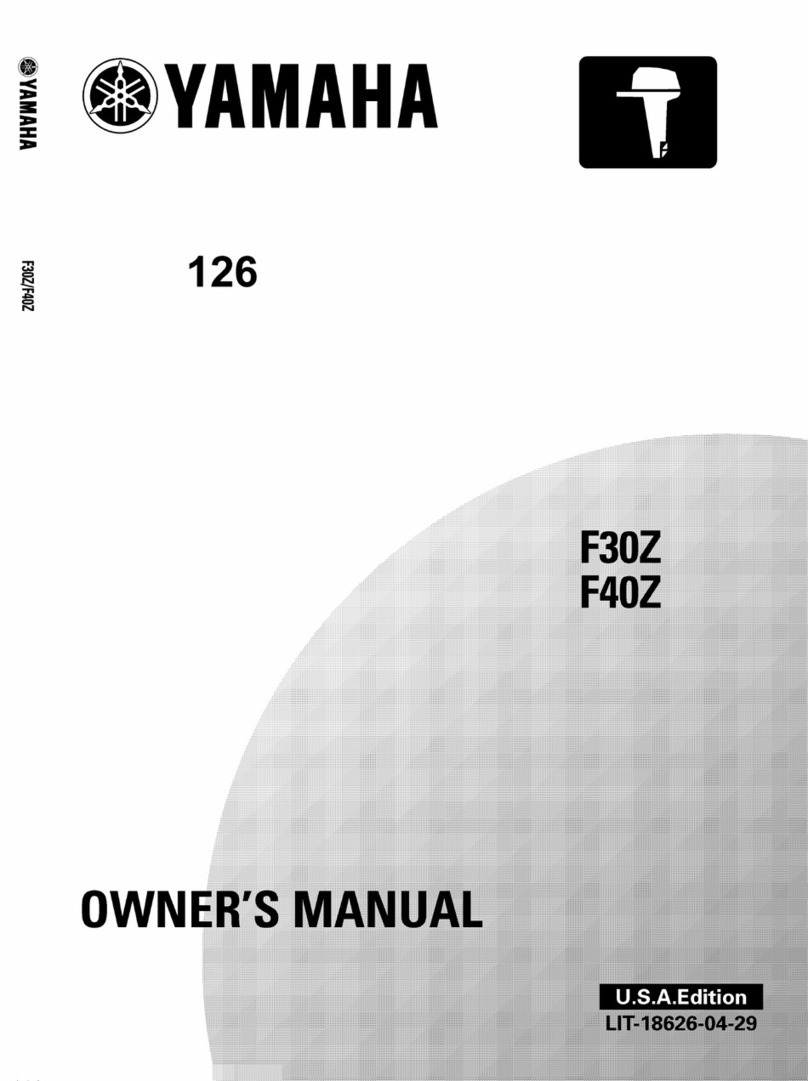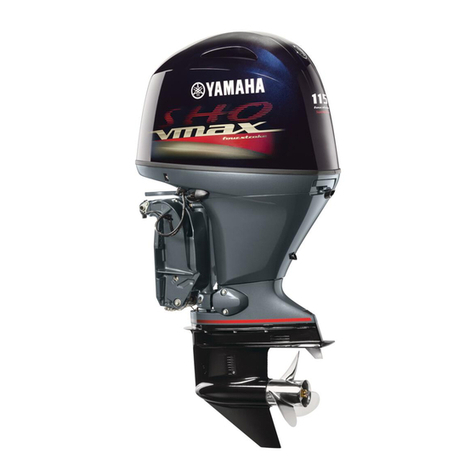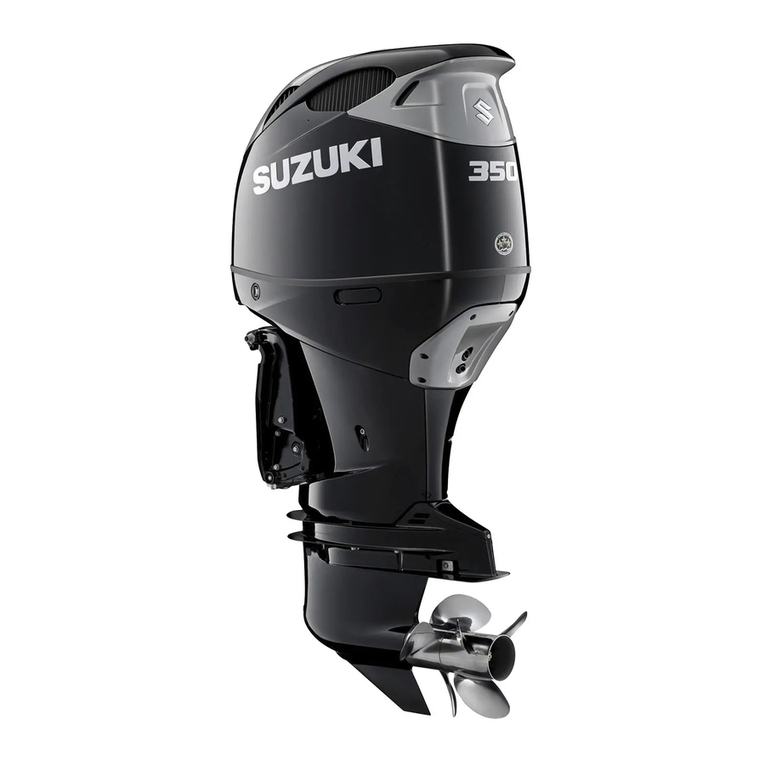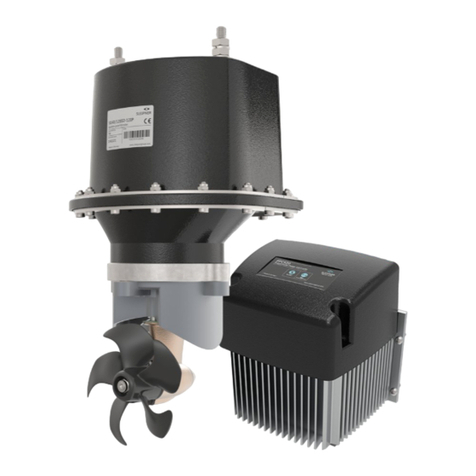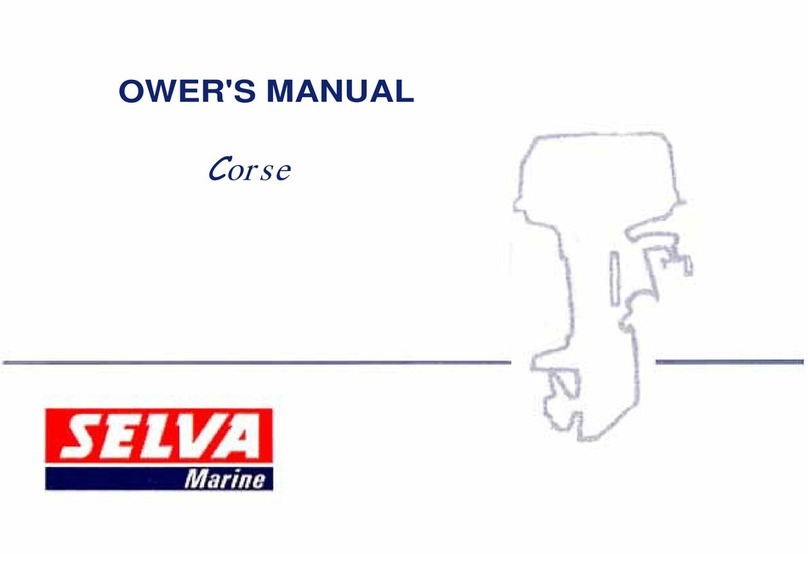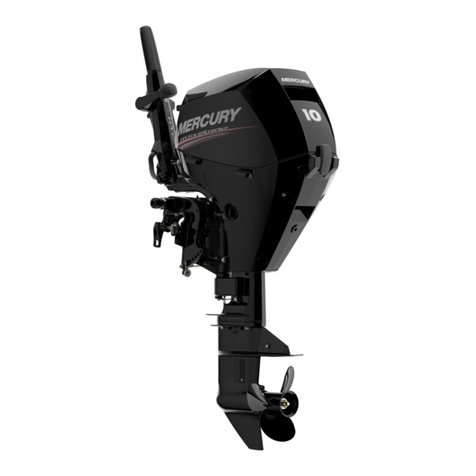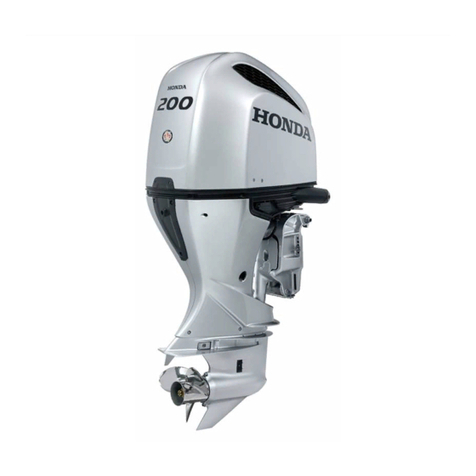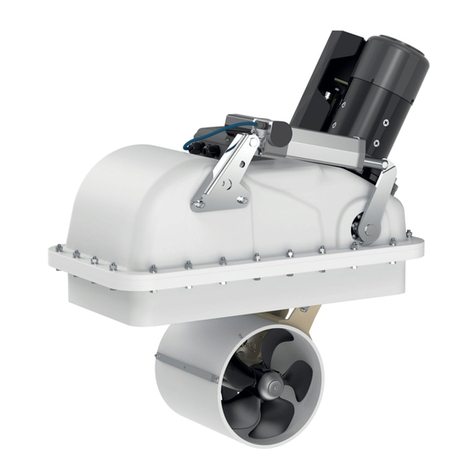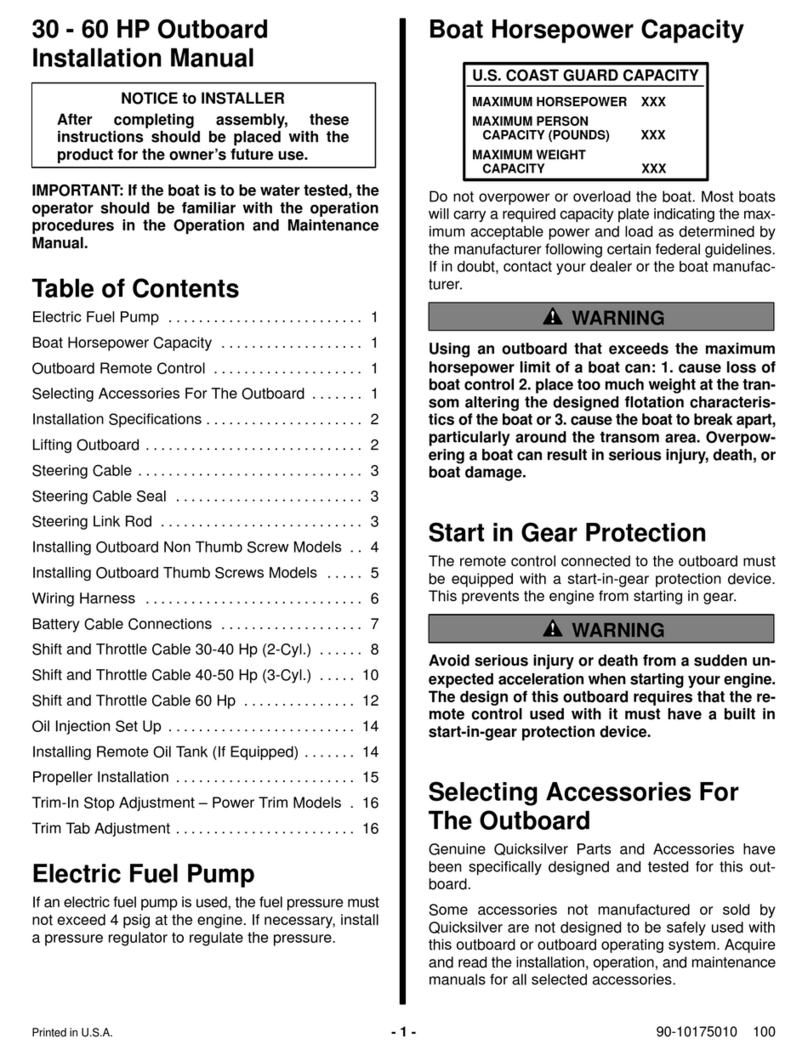Yamaha F4A User manual

OWNER’S MANUAL
F4A
68D-F8199-76-E0
✼✩✫✱✪✩✲✣✻ ✤

EMU25050
Read this owner’s manual carefully before operating your outboard motor.
✼✩✫✱✪✩✲✣✻ ✤

Important manual information
EMU25101
To the owner
Thank you for choosing a Yamaha outboard
motor. This Owner’s Manual contains infor-
mation needed for proper operation, mainte-
nance and care. A thorough understanding
of these simple instructions will help you ob-
tain maximum enjoyment from your new
Yamaha. If you have any question about the
operation or maintenance of your outboard
motor, please consult a Yamaha dealer.
In this Owner’s Manual particularly important
information is distinguished in the following
ways.
The Safety Alert Symbol means
ATTENTION! BECOME ALERT! YOUR
SAFETY IS INVOLVED!
WARNING
EWM00780
Failure to follow WARNING instructions
could result in severe injury or death to
the machine operator, a bystander, or a
person inspecting or repairing the out-
board motor.
CAUTION:
ECM00700
A CAUTION indicates special precautions
that must be taken to avoid damage to the
outboard motor.
NOTE:
A NOTE provides key information to make
procedures easier or clearer.
Yamaha continually seeks advancements in
product design and quality. Therefore, while
this manual contains the most current prod-
uct information available at the time of print-
ing, there may be minor discrepancies
between your machine and this manual. If
there is any question concerning this manu-
al, please consult your Yamaha dealer.
To ensure long product life, Yamaha recom-
mends that you use the product and perform
the specified periodic inspections and main-
tenance by correctly following the instruc-
tions in the owner’s manual. Note that if you
do not follow these instructions, not only may
the product break down, but the warranty will
also be voided.
Some countries have laws or regulations re-
stricting users from taking the product out of
the country where it was purchased, and it
may be impossible to register the product in
the destination country. Additionally, the
warranty may not apply in certain regions.
When planning to take the product to another
country, consult the dealer where the prod-
uct was purchased for further information.
If the product was purchased used, please
consult your closest dealer for customer re-
registration, and to be eligible for the speci-
fied services.
NOTE:
The F4AMH and the standard accessories
are used as a base for the explanations and
illustrations in this manual. Therefore some
items may not apply to every model.
EMU25140
F4A
OWNER’S MANUAL
©2006 by Yamaha Motor Co., Ltd.
1st Edition, February 2006
All rights reserved.
Any reprinting or unauthorized use
without the written permission of
Yamaha Motor Co., Ltd.
is expressly prohibited.
Printed in France
✼✩✫✱✪✩✲✣✻ ✤

Table of contents
General information .......................... 1
Identification numbers record.......... 1
Outboard motor serial number .......... 1
EC label........................................... 1
Emission control information ........... 1
SAV models ...................................... 1
Safety information ........................... 2
Important labels............................... 3
Warning labels .................................. 3
Caution labels ................................... 4
Fueling instructions ......................... 4
Gasoline............................................ 5
Engine oil .......................................... 5
Propeller selection........................... 5
Start-in-gear protection ................... 6
Basic components ............................ 7
Main components............................ 7
Fuel tank ........................................... 7
Fuel tank ........................................... 8
Fuel joint ........................................... 8
Fuel gauge ........................................ 8
Fuel tank cap .................................... 8
Air vent screw ................................... 8
Fuel cock........................................... 8
Open ................................................. 9
Tiller handle ...................................... 9
Gear shift lever.................................. 9
Throttle grip..................................... 10
Throttle indicator ............................. 10
Throttle friction adjuster................... 10
Engine stop lanyard switch ............. 11
Engine stop button .......................... 11
Choke knob for pull type ................. 11
Manual starter handle ..................... 12
Steering friction adjuster ................. 12
Trim rod (tilt pin).............................. 12
Tilt lock mechanism......................... 12
Tilt support bar ................................ 12
Top cowling lock lever (pull up
type).............................................. 13
Carrying handle............................... 13
Operation ......................................... 14
Installation ..................................... 14
Mounting the outboard motor.......... 14
Clamping the outboard motor ......... 15
Breaking in engine ........................ 16
Procedure for 4-stroke models........ 16
Preoperation checks ..................... 16
Fuel ................................................. 16
Controls ........................................... 17
Engine ............................................. 17
Checking the engine oil level ..........17
Filling fuel...................................... 17
Operating engine .......................... 18
Feeding fuel .................................... 18
Starting engine ................................ 19
Warming up engine....................... 21
Manual start models........................ 21
Shifting.......................................... 21
Forward (tiller handle and remote
control models) ............................. 22
Reverse ........................................... 22
Stopping engine............................ 22
Procedure........................................ 22
Trimming outboard motor.............. 23
Adjusting trim angle for manual
tilt models...................................... 24
Adjusting boat trim ..........................24
Tilting up and down....................... 25
Procedure for tilting up (manual
tilt models)..................................... 26
Procedure for tilting down
(manual tilt models).......................27
Cruising in shallow water .............. 28
Cruising in shallow water
(manual tilt models).......................28
Cruising in other conditions........... 29
Maintenance .................................... 30
Specifications................................ 30
Transporting and storing
outboard motor ........................... 31
Clamp screw mounting models ....... 31
Storing outboard motor ...................32
Procedure........................................ 32
Lubrication (except oil injection
models) ......................................... 34
Cleaning the outboard motor........... 34
Checking painted surface of
motor............................................. 34
Periodic maintenance ................... 34
✼✩✫✱✪✩✲✣✻ ✤

Table of contents
Replacement parts.......................... 34
Maintenance chart .......................... 35
Maintenance chart (additional)........ 36
Greasing ......................................... 37
Cleaning and adjusting spark
plug ............................................... 37
Checking fuel system...................... 38
Checking fuel filter .......................... 39
Inspecting idling speed ................... 39
Changing engine oil ........................ 39
Checking wiring and connectors ..... 41
Exhaust leakage ............................. 41
Water leakage................................. 41
Engine oil leakage........................... 41
Checking propeller .......................... 41
Removing the propeller................... 42
Installing the Propeller .................... 42
Changing gear oil............................ 43
Cleaning fuel tank ........................... 44
Inspecting and replacing
anode(s)........................................ 44
Checking top cowling ...................... 45
Coating the boat bottom.................. 45
Trouble Recovery ............................ 46
Troubleshooting ............................ 46
Temporary action in
emergency .................................. 49
Impact damage ............................... 49
Starter will not operate .................... 49
Emergency starting engine ............. 50
Treatment of submerged motor..... 51
Procedure ....................................... 51
✼✩✫✱✪✩✲✣✻ ✥

1
General information
EMU25170
Identification numbers record
EMU25183
Outboard motor serial number
The outboard motor serial number is
stamped on the label attached to the port
side of the clamp bracket.
Record your outboard motor serial number in
the spaces provided to assist you in ordering
spare parts from your Yamaha dealer or for
reference in case your outboard motor is sto-
len.
EMU25202
EC label
Engines affixed with this label conform to
certain portions of the European Parliament
directive relating to machinery. Refer to the
label and the EC Declaration of Conformity
for more details.
EMU25221
Emission control information
EMU25351
SAV models
Engines affixed with the label pictured below
conform to SAV (the Swiss exhaust emission
regulations for Swiss inshore waters).
1. Outboard motor serial number location
1. EC label location
ZMU02651
1
ZMU01696
✼✩✫✱✪✩✲✣✻ ✤

General information
2
Approval label of emission control certif-
icate
Fuel requirement label
EMU25371
Safety information
●
Before mounting or operating the outboard
motor, read this entire manual. Reading it
should give you an understanding of the
motor and its operation.
●
Before operating the boat, read any own-
er’s or operator’s manuals supplied with it
and all labels. Be sure you understand
each item before operating.
●
Do not overpower the boat with this out-
board motor. Overpowering the boat could
result in loss of control. The rated power of
the outboard should be equal to or less
than the rated horsepower capacity of the
boat. If the rated horsepower capacity of
the boat is unknown, consult the dealer or
boat manufacturer.
●
Do not modify the outboard. Modifications
could make the motor unfit or unsafe to
use.
●
Incorrect propeller selection and incorrect
use may not only cause engine damage,
but also adversely affect fuel consumption.
Consult your dealer for correct use.
●
Never operate after drinking alcohol or tak-
ing drugs. About 50% of all boating fatali-
ties involve intoxication.
●
Have an approved personal flotation de-
vice (PFD) on board for every occupant. It
is a good idea to wear a PFD whenever
boating. At a minimum, children and non-
swimmers should always wear PFDs, and
1. Approval label location
1. Fuel requirement label location
1
ZMU04493
YAMAHA MOTOR CO.,LTD.
Motorfamilie
Abgastypenpruf-
Nummer
ZMU04492
1
ZMU04495
ZMU04494
✼✩✫✱✪✩✲✣✻ ✥

General information
3
everyone should wear PFDs when there
are potentially hazardous boating condi-
tions.
●
Gasoline is highly flammable, and its va-
pors are flammable and explosive. Handle
and store gasoline carefully. Make sure
there are no gas fumes or leaking fuel be-
fore starting the engine.
●
This product emits exhaust gases which
contain carbon monoxide, a colorless,
odorless gas which may cause brain dam-
age or death when inhaled. Symptoms in-
clude nausea, dizziness, and drowsiness.
Keep cockpit and cabin areas well ventilat-
ed. Avoid blocking exhaust outlets.
●
Check throttle, shift, and steering for prop-
er operation before starting the engine.
●
Attach the engine stop switch lanyard to a
secure place on your clothing, or your arm
or leg while operating. If you accidentally
leave the helm, the lanyard will pull from
the switch, stopping the engine.
●
Know the marine laws and regulations
where you will be boating - and obey them.
●
Stay informed about the weather. Check
weather forecasts before boating. Avoid
boating in hazardous weather.
●
Tell someone where you are going: leave
a Float Plan with a responsible person. Be
sure to cancel the Float Plan when you re-
turn.
●
Use common sense and good judgment
when boating. Know your abilities, and be
sure you understand how your boat han-
dles under the different boating conditions
you may encounter. Operate within your
limits, and the limits of your boat. Always
operate at safe speeds, and keep a careful
watch for obstacles and other traffic.
●
Always watch carefully for swimmers dur-
ing the engine operation.
●
Stay away from swimming areas.
●
When a swimmer is in the water near you
shift into neutral and shut off the engine.
●
Do not illegally discard empty containers
used to replace or replenish oil. For the
correct processing of empty containers,
consult the dealer where you purchased
the oil.
●
When replacing oils used to lubricate the
product (engine or gear oil), be sure to
wipe away any spilt oil. Never pour oil with-
out using a funnel or similar device. If nec-
essary, verify the necessary replacement
procedure with the dealer.
●
Never illegally discard (dump) the product.
Yamaha recommends consulting the deal-
er on discarding the product.
EMU25382
Important labels
EMU25395
Warning labels
EMU25401
Label
WARNING
EWM01260
●
Be sure shift control is in neutral before
starting engine. (except 2HP)
●
Do not touch or remove electrical parts
when starting or during operation.
●
Keep hands, hair, and clothes away
from flywheel and other rotating parts
ZMU04496
✼✩✫✱✪✩✲✣✻ ✦

General information
4
while engine is running.
EMU25431
Label
WARNING
EWM01300
●
This engine is equipped with a neutral
starting device.
●
The engine will not start unless the shift
control is in neutral position.
EMU25441
Label
WARNING
EWM01311
LEAKING FUEL COULD CAUSE A FIRE.
Before tilting up the engine or laying it on
its side:
●
Turn the fuel cock to the “closed”posi-
tion.
●
Tighten the air-vent screw on the fuel
tank cap.
EMU25465
Caution labels
EMU25482
Label
CAUTION:
ECM01201
Store the engine only as shown.
Otherwise, engine damage could result
from leaking oil.
EMU25540
Fueling instructions
WARNING
EWM00010
GASOLINE AND ITS VAPORS ARE HIGH-
LY FLAMMABLE AND EXPLOSIVE!
●
Do not smoke when refueling, and keep
away from sparks, flames, or other
sources of ignition.
●
Stop engine before refueling.
●
Refuel in a well-ventilated area. Refuel
portable fuel tanks off the boat.
●
Take care not to spill gasoline. If gaso-
line spills, wipe it up immediately with
dry rags.
●
Do not overfill the fuel tank.
●
Tighten the filler cap securely after re-
fueling.
●
If you should swallow some gasoline,
inhale a lot of gasoline vapor, or get
gasoline in your eyes, get immediate
medical attention.
●
If any gasoline spills onto your skin, im-
mediately wash with soap and water.
Change clothing if gasoline spills on it.
●
Touch the fuel nozzle to the filler open-
ing or funnel to help prevent electro-
static sparks.
CAUTION:
ECM00010
Use only new clean gasoline which has
been stored in clean containers and is not
contaminated with water or foreign mat-
ter.
ZMU02655
✼✩✫✱✪✩✲✣✻ ✧

General information
5
EMU25580
Gasoline
If knocking or pinging occurs, use a different
brand of gasoline or premium unleaded fuel.
EMU25683
Engine oil
NOTE:
If the recommended engine oil grades are
not available, select an alternative from the
following chart according to the average
temperatures in your area.
CAUTION:
ECM01050
All 4-stroke engines are shipped from the
factory without engine oil.
EMU25742
Propeller selection
The performance of your outboard motor will
be critically affected by your choice of propel-
ler, as an incorrect choice could adversely
affect performance and could also seriously
damage the motor. Engine speed depends
on the propeller size and boat load. If engine
speed is too high or too low for good engine
performance, this will have an adverse effect
on the engine.
Yamaha outboard motors are fitted with pro-
Recommended gasoline:
Regular unleaded gasoline with a min-
imum octane rating of 90 (Research
Octane Number).
Recommended engine oil:
4-stroke motor oil with a combination
of the following SAE and API oil classi-
fications
Engine oil type SAE:
10W-30 or 10W-40
Engine oil grade API:
SE, SF, SG, SH, SJ, SL
Engine oil quantity (excluding oil filter):
0.5 L (0.53 US qt) (0.44 Imp.qt)
ZMU01710
✼✩✫✱✪✩✲✣✻

General information
6
pellers chosen to perform well over a range
of applications, but there may be uses where
a propeller with a different pitch would be
more appropriate. For a greater operating
load, a smaller-pitch propeller is more suit-
able as it enables the correct engine speed
to be maintained. Conversely, a larger-pitch
propeller is more suitable for a smaller oper-
ating load.
Yamaha dealers stock a range of propellers,
and can advise you and install a propeller on
your outboard that is best suited to your ap-
plication.
NOTE:
Select a propeller which will allow the engine
to reach the middle or upper half of the oper-
ating range at full throttle with the maximum
boat load. If operating conditions such as
light boat loads then allow the engine r/min to
rise above the maximum recommended
range, reduce the throttle setting to maintain
the engine in the proper operating range.
For instructions on propeller removal and in-
stallation, see page 41.
EMU25760
Start-in-gear protection
Yamaha outboard motors affixed with the
pictured label or Yamaha-approved remote
control units are equipped with start-in-gear
protection device(s). This feature permits the
engine to be started only when it is in neutral.
Always select neutral before starting the en-
gine.
1. Propeller diameter in inches
2. Propeller pitch in inches
3. Type of propeller (propeller mark)
ZMU04604
-
x
123
1. Start-in-gear protection label
ZMU01713
1
✼✩✫✱✪✩✲✣✻ ✩

7
Basic components
EMU25797
Main components
NOTE:
* May not be exactly as shown; also may not be included as standard equipment on all mod-
els.
F4A
EMU25802
Fuel tank
If your model was equipped with a portable
fuel tank, its function is as follows.
WARNING
EWM00020
The fuel tank supplied with this engine is
1
2
4
8
7
6
9
3
5
10
2
11
14
18
17
16
13
12
15
19
ZMU04483
20
1. Top cowling
2. Top cowling lock lever
3. Carrying handle
4. Steering friction screw
5. Anti-cavitation plate
6. Propeller
7. Cooling water inlet
8. Trim rod
9. Clamp bracket
10. Tiller handle
11. Air vent screw
12. Fuel tank cap
13. Manual starter handle
14. Engine stop button/Engine stop lanyard
switch
15. Clamp screw
16. Rope attachment
17. Fuel joint
18. Choke knob
19. Gear shift lever
20. Fuel tank*
✼✩✫✱✪✩✲✣✻ ✪

Basic components
8
its dedicated fuel reservoir and must not
be used as a fuel storage container. Com-
mercial users should conform to relevant
licensing or approval authority regula-
tions.
EMU25821
Fuel tank
If your model included a fuel tank, its parts
and functions are as follows.
EMU25830
Fuel joint
This joint is used to connect the fuel line.
EMU25841
Fuel gauge
This gauge is located on either the fuel tank
cap or on the fuel joint base. It shows the ap-
proximate amount of fuel remaining in the
tank.
EMU25850
Fuel tank cap
This cap seals the fuel tank. When removed,
the tank can be filled with fuel. To remove the
cap, turn it counterclockwise.
EMU25860
Air vent screw
This screw is on the fuel tank cap. To loosen
the screw, turn it counterclockwise.
EMU25872
Fuel cock
The fuel cock turns on and off the supply of
fuel from the fuel tank to the engine.
EMU25881
Close
To stop fuel flow to the engine, turn the lever
or knob to close position.
Always turn the lever or knob to close posi-
tion when the engine is not running.
1. Air vent screw
2. Fuel gauge
3. Fuel joint
4. Fuel tank cap
1. Air vent screw
2. Built-in fuel tank
3. Fuel tank cap
ZMU01992
32
41
ZMU02658
1
3
2
1. Fuel cock
ZMU02659
1
✼✩✫✱✪✩✲✣✻ ✫

Basic components
9
EMU25901
Open
The fuel cock has two open positions, one for
selecting fuel flow from the built-in fuel tank,
and one for an external tank.
Fuel flows to the carburetor with the lever or
knob in either open position. These are the
normal running positions.
EMU25911
Tiller handle
To change direction, move the tiller handle to
the left or right as necessary.
EMU25922
Gear shift lever
Pulling the gear shift lever towards you puts
the engine in forward gear so that the boat
moves ahead. Pushing the lever away from
you puts the engine in reverse gear so that
the boat moves astern.
1. Close position
1. “OPEN”position for the built-in tank
ZMU02659
1
ZMU02661
1
1. “OPEN”position for the portable tank
ZMU02652
1
ZMU02662
✼✩✫✱✪✩✲✣✻ ✬

Basic components
10
EMU25941
Throttle grip
The throttle grip is on the tiller handle. Turn
the grip counterclockwise to increase speed
and clockwise to decrease speed.
EMU25961
Throttle indicator
The fuel consumption curve on the throttle
indicator shows the relative amount of fuel
consumed for each throttle position. Choose
the setting that offers the best performance
and fuel economy for the desired operation.
EMU25971
Throttle friction adjuster
A friction device provides adjustable resis-
tance to movement of the throttle grip or the
remote control lever, and can be set accord-
ing to operator preference.
To increase resistance, turn the adjuster
clockwise. To decrease resistance, turn the
adjuster counterclockwise.
WARNING
EWM00031
Do not overtighten the friction adjuster. If
there is too much resistance, it could be
difficult to move the remote control lever
or throttle grip, which could result in an
accident.
When constant speed is desired, tighten the
adjuster to maintain the desired throttle set-
ting.
1. Forward “”
2. Neutral “”
3. Reverse “”
2
N
1
F
3
R
ZMU02663
ZMU02664
1. Throttle indicator
1
ZMU02665
ZMU02666
✼✩✫✱✪✩✲✣✻ ✤✣

Basic components
11
EMU25990
Engine stop lanyard switch
The lock plate must be attached to the en-
gine stop switch for the engine to run. The
lanyard should be attached to a secure place
on the operator’s clothing, or arm or leg.
Should the operator fall overboard or leave
the helm, the lanyard will pull out the lock
plate, stopping ignition to the engine. This
will prevent the boat from running away un-
der power.
WARNING
EWM00120
●
Attach the engine stop switch lanyard
to a secure place on your clothing, or
your arm or leg while operating.
●
Do not attach the lanyard to clothing
that could tear loose. Do not route the
lanyard where it could become entan-
gled, preventing it from functioning.
●
Avoid accidentally pulling the lanyard
during normal operation. Loss of en-
gine power means the loss of most
steering control. Also, without engine
power, the boat could slow rapidly. This
could cause people and objects in the
boat to be thrown forward.
NOTE:
The engine cannot be started with the lock
plate removed.
EMU26001
Engine stop button
To open the ignition circuit and stop the en-
gine, push this button.
EMU26011
Choke knob for pull type
To supply the engine with the rich fuel mix-
ture required to start, pull out this knob.
1. Lanyard
2. Lock plate
2
1
ZMU02667
ZMU02668
ZMU02669
✼✩✫✱✪✩✲✣✻ ✤✤

Basic components
12
EMU26070
Manual starter handle
To start the engine, first gently pull the han-
dle out until resistance is felt. From that posi-
tion, then pull the handle straight out quickly
to crank the engine.
EMU26122
Steering friction adjuster
A friction device provides adjustable resis-
tance to the steering mechanism, and can be
set according to operator preference. An ad-
justing screw or bolt is located on the swivel
bracket.
To increase resistance, turn the adjuster
clockwise.
To decrease resistance, turn the adjuster
counterclockwise.
WARNING
EWM00040
Do not overtighten the friction adjuster. If
there is too much resistance, it could be
difficult to steer, which could result in an
accident.
EMU26261
Trim rod (tilt pin)
The position of the trim rod determines the
minimum trim angle of the outboard motor in
relation to the transom.
EMU26312
Tilt lock mechanism
The tilt lock mechanism is used to prevent
the outboard motor from lifting out of the wa-
ter when in reverse gear.
To lock it, set the tilt lock lever in the “”
(lock) position. To release, push the tilt lock
lever in the “”(release) position.
EMU26330
Tilt support bar
The tilt support bar keeps the outboard motor
in the tilted up position.
ZMU02670
ZMU02671
1. Tilt lock lever
ZMU02672
ZMU04497
1
✼✩✫✱✪✩✲✣✻ ✤✥

Basic components
13
EMU26382
Top cowling lock lever (pull up type)
To remove the engine top cowling, pull up
the lock lever(s) and lift off the cowling.
When installing the cowling, check to be sure
it fits properly in the rubber seal. Then lock
the cowling by moving the lever(s) down-
ward.
EMU26450
Carrying handle
A carrying handle is provided on the rear of
the outboard motor. It enables you to carry
the outboard motor easily with one hand.
1. Top cowling lock lever(s)
1. Top cowling lock lever(s)
ZMU02674
ZMU02675
1
ZMU04522
1
1. Carrying handle
ZMU02676
1
✼✩✫✱✪✩✲✣✻ ✤✦

14
Operation
EMU26901
Installation
CAUTION:
ECM00110
Incorrect engine height or obstructions
to smooth water flow (such as the design
or condition of the boat, or accessories
such as transom ladders or depth finder
transducers) can create airborne water
spray while the boat is cruising. Severe
engine damage may result if the motor is
operated continuously in the presence of
airborne water spray.
NOTE:
During water testing check the buoyancy of
the boat, at rest, with its maximum load.
Check that the static water level on the ex-
haust housing is low enough to prevent wa-
ter entry into the powerhead, when water
rises due to waves when the outboard is not
running.
EMU26910
Mounting the outboard motor
WARNING
EWM00820
●
Overpowering a boat could cause se-
vere instability. Do not install an out-
board motor with more horsepower
than the maximum rating on the capac-
ity plate of the boat. If the boat does not
have a capacity plate, consult the boat
manufacturer.
●
The information presented in this sec-
tion is intended as reference only. It is
not possible to provide complete in-
structions for every possible boat and
motor combination. Proper mounting
depends in part on experience and the
specific boat and motor combination.
WARNING
EWM00830
Improper mounting of the outboard mo-
tor could result in hazardous conditions
such as poor handling, loss of control, or
fire hazards. Observe the following:
●
For permanently mounted models, your
dealer or other person experienced in
proper rigging should mount the motor.
If you are mounting the motor yourself,
you should be trained by an experi-
enced person.
●
For portable models, your dealer or oth-
er person experienced in proper out-
board motor mounting should show
you how to mount your motor.
Mount the outboard motor on the center line
(keel line) of the boat, and ensure that the
boat itself is well balanced. Otherwise the
boat will be hard to steer. For boats without
a keel or which are asymmetrical, consult
your dealer.
EMU26920
Mounting height
To run your boat at optimum efficiency, the
water resistance (drag) of the boat and out-
board motor must be made as little as possi-
ble. The mounting height of the outboard
1. Center line (keel line)
ZMU01760
1
✼✩✫✱✪✩✲✣✻ ✤✧

Operation
15
motor greatly affects the water resistance. If
the mounting height is too high, cavitation
tends to occur, thus reducing the propulsion;
and if the propeller tips cut the air, the engine
speed will rise abnormally and cause the en-
gine to overheat. If the mounting height is too
low, the water resistance will increase and
thereby reduce engine efficiency. Mount the
outboard motor so that the anti-cavitation
plate is between the bottom of the boat and
a level 25 mm (1 in.) below it.
NOTE:
●
The optimum mounting height of the out-
board motor is affected by the boat and
motor combination and the desired use.
Test runs at different heights can help de-
termine the optimum mounting height.
Consult your Yamaha dealer or boat man-
ufacturer for further information on deter-
mining the proper mounting height.
●
For instructions on setting the trim angle of
the outboard motor, see page 23.
EMU26970
Clamping the outboard motor
1. Place the outboard motor on the tran-
som so that it is positioned as close to
the center as possible. Tighten the tran-
som clamp screws evenly and securely.
Occasionally check the clamp screws
for tightness during operation of the out-
board motor because they could be-
come loose due to engine vibration.
WARNING
EWM00640
Loose clamp screws could allow the out-
board motor to fall off or move on the
transom. This could cause loss of control
and serious injury. Make sure the tran-
som screws are tightened securely. Oc-
casionally check the screws for tightness
during operation.
2. If the engine restraint cable attachment
is equipped on your engine, an engine
restraint cable or chain should be used.
Attach one end to the engine restraint
cable attachment and the other to a se-
cure mounting point on the boat. Other-
wise the engine could be completely lost
if it accidentally falls off the transom.
3. Secure the clamp bracket to the transom
using the bolts provided with the out-
ZMU02011
0–25mm
(0–1in.)
ZMU02012
ZMU02013
✼✩✫✱✪✩✲✣✻ ✤
Other manuals for F4A
4
Table of contents
Other Yamaha Outboard Motor manuals

Yamaha
Yamaha F20A User manual
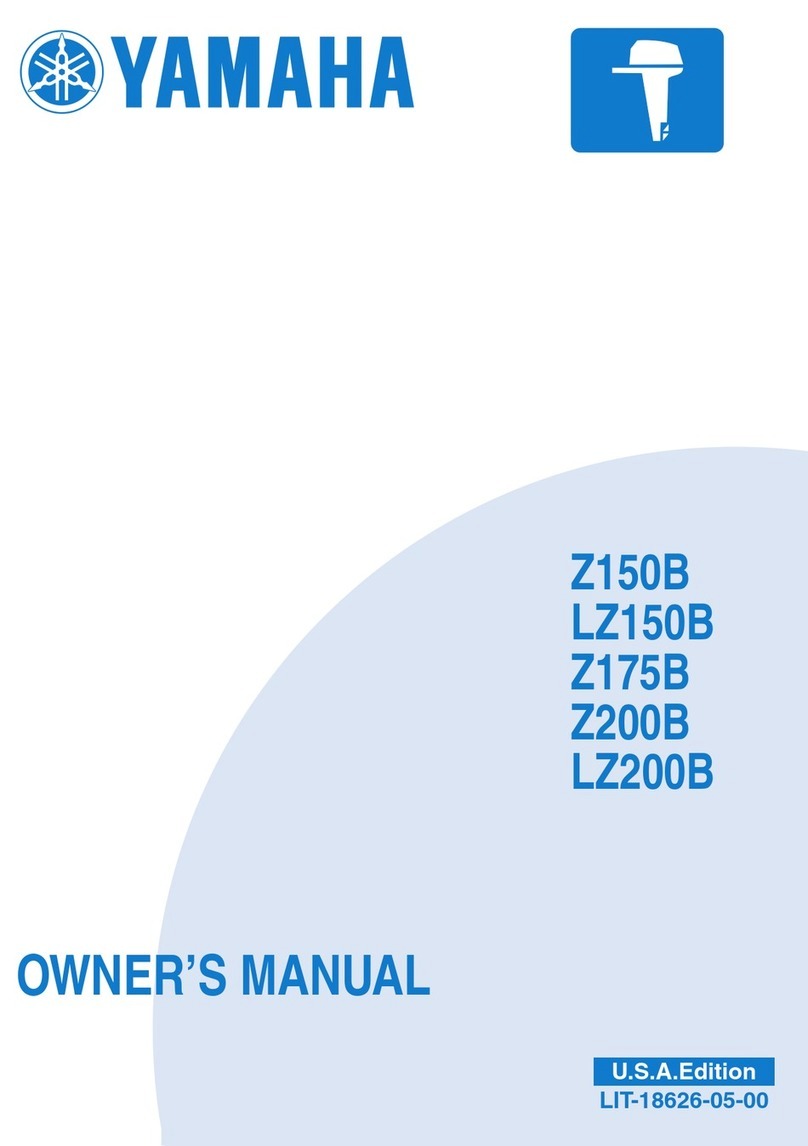
Yamaha
Yamaha Z150B User manual

Yamaha
Yamaha 25B User manual

Yamaha
Yamaha VX200A User manual
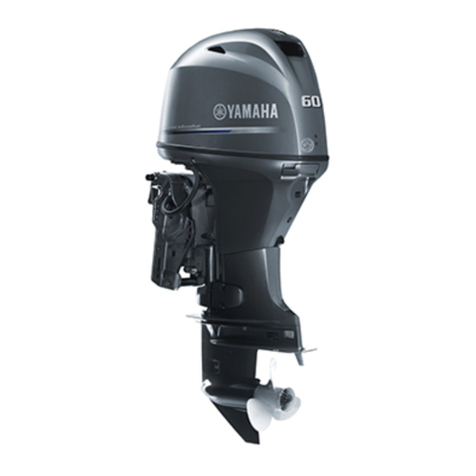
Yamaha
Yamaha 90A User manual
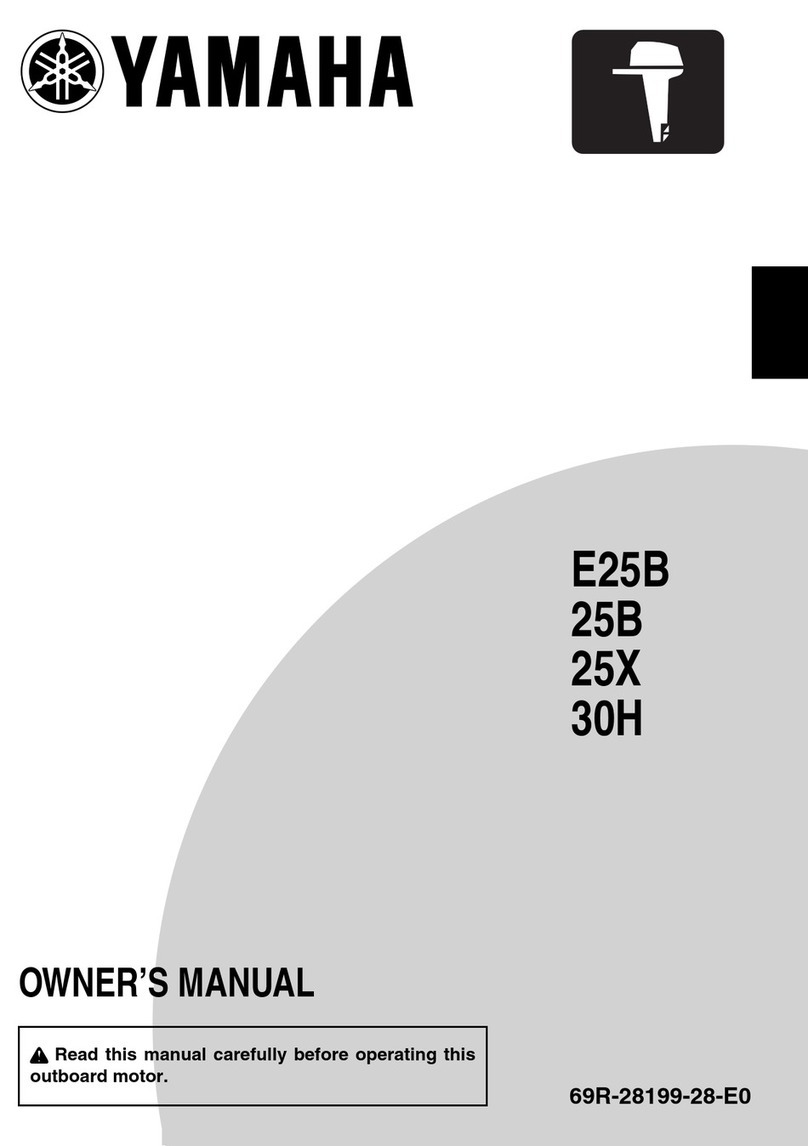
Yamaha
Yamaha E25B User manual
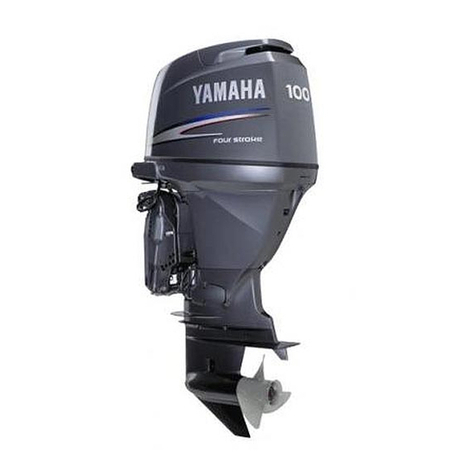
Yamaha
Yamaha F100A User manual
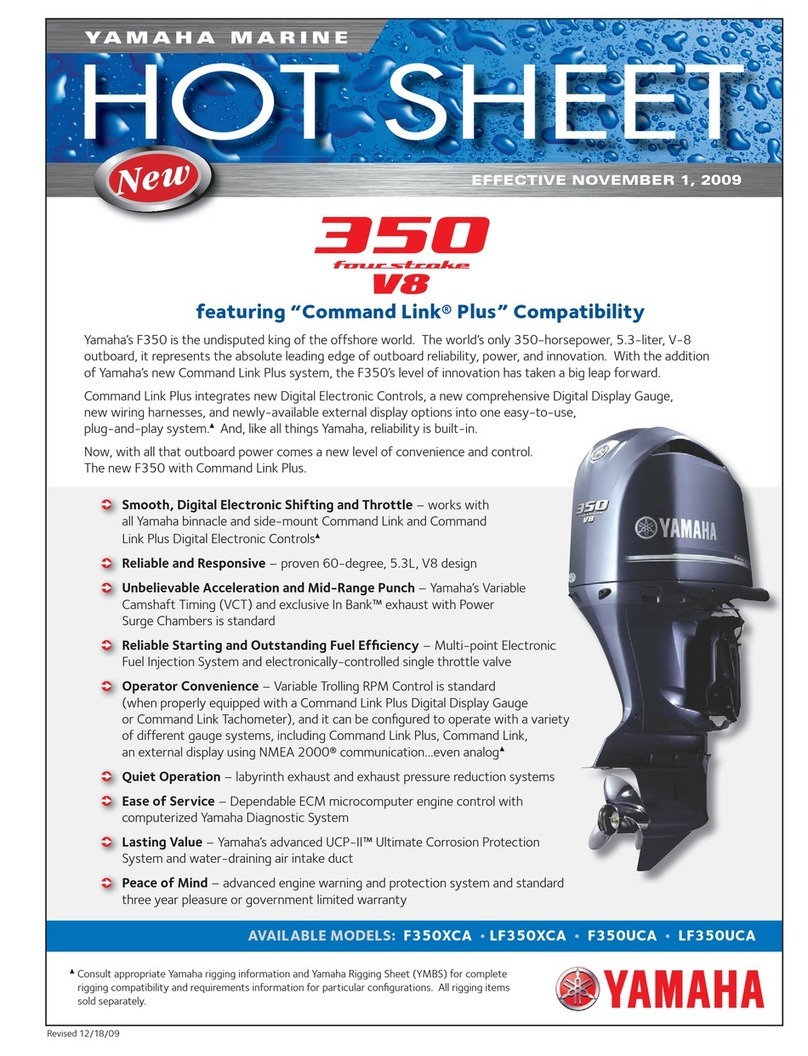
Yamaha
Yamaha 350 FourStrake V8 User manual
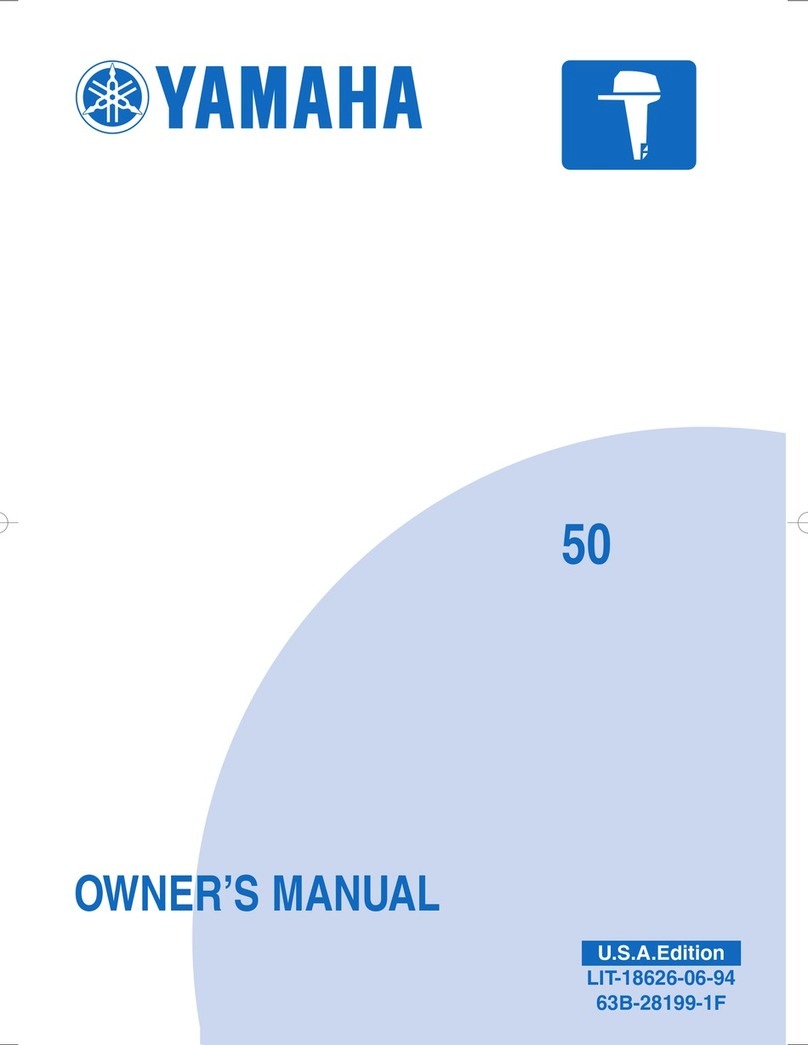
Yamaha
Yamaha 50 User manual

Yamaha
Yamaha MZ360 User manual
